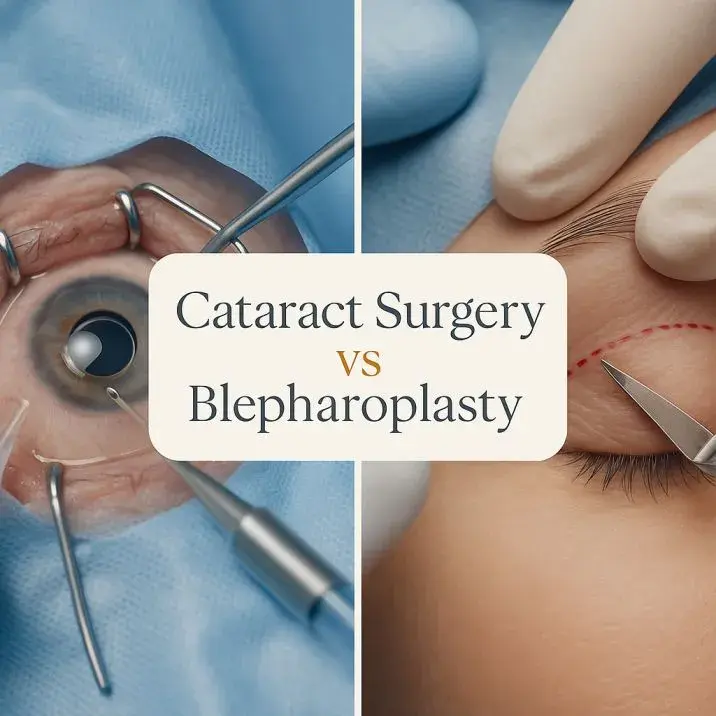What are the Best Stitches for Eyelid Surgery?
- Eyes Defined

- Apr 16, 2023
- 4 min read
Updated: Apr 17, 2023
Are you tired of constantly being asked if you're tired? Do your droopy eyelids make you look older than you really are? Fear not, because the answer to your woes is here: eyelid surgery! Also known as blepharoplasty or an eyelid lift, this popular cosmetic procedure can work wonders in reviving your eyes and giving you a more youthful appearance.

Eyelid surgery involves removing excess skin and fat from either the upper or lower eyelids, or both. It can also address issues such as sagging eyebrows and under-eye bags. The procedure is typically performed on an outpatient basis using local anesthesia, making it a quick and relatively painless experience with minimal downtime.
Not only does eyelid surgery improve the aesthetics of your face by creating a more alert and refreshed look, it can also have functional benefits such as improving vision obstruction caused by sagging upper eyelids.
Procedure: Types of Stitches
Are you curious about the different types of skin stitches? Well, you've come to the right place! Whether it's for a minor injury or a major surgical procedure, stitches are essential in helping wounds heal and reduce scarring. There are two main categories of stitches: absorbable and non-absorbable.
Absorbable sutures dissolve over time as the body heals, eliminating the need for removal. They're typically made from materials like catgut, which is derived from sheep or cow intestines, or synthetic materials such as polydioxanone (PDS) or polylactic acid (PLA). These types of sutures are excellent for internal tissues since they don't require removal and won't cause irritation on the skin surface.
Non-absorbable sutures are stronger than absorbable ones and must be removed once healing is complete.
Benefits: Rapid Healing
If you've ever had a cut that just wouldn't stop bleeding, chances are you needed some skin stitches to close up the wound. Skin stitches have been used for centuries as a tried and true method for closing up deep cuts or incisions on the skin. But did you know there are different types of skin stitches available? There are absorbable and non-absorbable options, each with its own set of benefits.
Absorbable stitches provide rapid healing by breaking down naturally in the body over time. They're usually made from materials like catgut or polyglactin, which can dissolve within days or weeks after being placed in the skin. This means that there's no need to remove them later on, making the healing process much more convenient than with non-absorbable stitches. In addition, they reduce scarring because they don't leave any foreign material behind once they break down.
Sutures: Best Choice
When it comes to suturing the skin, it is important to choose the right type of suture material. There are several options available including nylon, vicryl, prolene, and monocryl. Each of these materials has its own unique properties that make them suitable for different types of wounds.
Nylon sutures are a popular choice because they are strong and durable. They are often used for closing incisions in areas where there is tension on the skin such as the face or hands. Vicryl sutures on the other hand are absorbable meaning they dissolve over time which makes them ideal for internal stitches that don't need to be removed later.
Prolene is another popular suture material because it is flexible and easy to work with. It also provides good knot security making it an excellent choice for deep tissue closures.
Techniques: Effective Practices
Are you a medical professional looking for tips on how to suture skin perfectly? With just a few simple steps, you can achieve fantastic results and ensure your patients' wounds heal quickly.
The first step is to determine the type of bite you need for the particular wound. You can choose from simple interrupted bites or continuous sutures depending on the wound's location and size. The key is to place the needle at an angle that matches the skin edge's curvature so that it doesn't cause unnecessary tension or leave gaps when tied. Additionally, always start with knot tying at one end before moving onto other parts of the wound.
Another crucial factor is choosing the right suture size based on your patient's age, weight, and type of tissue involved.
Conclusion: Considerations
In conclusion, eyelid surgery is a great way to enhance your look and restore the youthful appearance of your eyes. With careful consideration, you can choose the best stitches for a successful outcome. By understanding the differences between the various types of stitches and their applications, you can feel confident in selecting the ones that are best for your specific needs. Whether your goal is to improve vision or reduce wrinkles or both, proper stitching will ensure that your eyelid surgery procedure gives you desired results.
Eyelid surgery is a delicate and precise procedure that requires the right kind of stitches. Whether you’re looking for a quick recovery, minimal scarring, or long-term results, there is a stitch option that can provide what you need. Sutures like 6-0 fast absorbing, 7-0 non absorbable, 6-0 prolene, and 5-0 monocryl are all great choices for achieving optimal results from your eyelid surgery. Contact us and Get your free video consultation




Comments